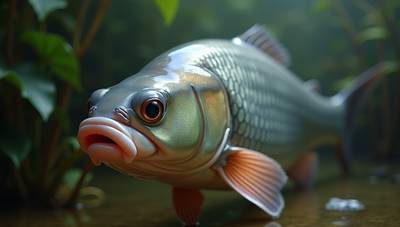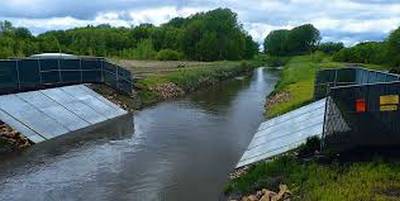What Does "Asian Carp" Mean?
In the United States, the term "Asian carp" refers to a group of highly invasive fish species from Asia that have infested North American waterways, particularly the Mississippi River basin. While many carp species are native to Asia, this term specifically targets four problematic invaders: Bighead, Silver, Black, and Grass Carp.
Imported for aquaculture in the 1960s and 70s, they escaped into the wild and thrived, thanks to their rapid growth, high reproduction rates, and lack of natural predators. Today, they pose one of the most significant threats to the health of native ecosystems and are the focus of intense management efforts to prevent their entry into the Great Lakes.
Asian Carp: The Key Facts
- The "Big Four": The term refers to Bighead, Silver, Black, and Grass Carp.
- The Problem: They out-compete native fish for food, destroy habitat, and disrupt the entire aquatic food web.
- The "Jumping Carp": Silver Carp are famous for leaping out of the water, creating a hazard for boaters.
- The Main Threat: Preventing their invasion of the Great Lakes is a top national priority.
The Four Key Invasive Species
These four species are the primary focus of "Asian carp" management in North America. Each has a unique impact:
- Bighead Carp (Hypophthalmichthys nobilis): A massive filter-feeder that eats zooplankton (microscopic animals), starving out native fish. Identified by its huge head, low-set eyes, and dark blotchy pattern.
- Silver Carp (Hypophthalmichthys molitrix): The infamous "jumping carp." A filter-feeder that eats phytoplankton (algae). Identified by its bright silver color, low-set eyes, and long belly keel.
- Black Carp (Mylopharyngodon piceus): A powerful mollusk-eater that threatens endangered native mussel and snail populations. Identified by its dark, almost black color and powerful throat teeth.
- Grass Carp (Ctenopharyngodon idella): An herbivore that can wipe out entire aquatic plant beds, destroying vital habitat for native fish and waterfowl.

Why Are They So Destructive?
The establishment of invasive Asian carp has profound consequences:
- They Steal the Food: Bighead and Silver Carp consume enormous amounts of plankton, the foundation of the aquatic food web. This starves the young of almost all native fish, including valuable sportfish like bass and crappie.
- They Destroy Habitat: Grass Carp can eliminate critical underwater plant beds that native fish use for spawning and cover. Black Carp destroy already fragile native mussel populations.
- They Are a Physical Danger: The jumping behavior of Silver Carp poses a serious safety risk to boaters and water-skiers, causing injuries and damaging property.
- They Threaten a Multi-Billion Dollar Fishery: Their potential invasion of the Great Lakes threatens a $7 billion fishing industry.
Management and Control Efforts
Preventing the spread and reducing populations of Asian carp is a massive, ongoing challenge. Eradication is considered impossible, so efforts focus on containment and control.

Key Strategies:
- Defending the Great Lakes: A top priority. This includes operating electric dispersal barriers in the Chicago Area Waterway System and researching new technologies like acoustic deterrents and bubble curtains.
- Population Reduction: Supporting commercial fishing and contracted removal programs to harvest millions of pounds of carp from rivers like the Illinois River each year.
- Containment: Identifying and blocking other potential pathways between river basins to stop their spread.
- Research and Development: Investing in new tools like species-specific toxins, pheromone attractants, and genetic controls.
- Public Awareness: Educating the public to "Clean, Drain, Dry" boats and never move live baitfish between water bodies.
How to Identify Invasive Asian Carp
The easiest way to distinguish these four invasive carp from native fish is that Asian carp do not have barbels (whiskers) around their mouths. The native Common Carp has two pairs of barbels. Furthermore, Bighead and Silver Carp are easily identified by their very large heads and low-set eyes (the center of the eye is below the corner of the mouth).
History of the Invasion
The story of the Asian carp invasion is a lesson in unintended consequences. They were imported in the 1960s-70s by fish farmers in Arkansas to clean aquaculture ponds. During major floods, they escaped into the Mississippi River basin, where they found ideal conditions and exploded in number, spreading throughout the connected river system.
Can We Use Them? Fishing and Eating Asian Carp
Turning the problem into a resource is a key part of the management strategy.
- Fishing: While Bighead and Silver Carp don't typically bite a hook, they are a hugely popular target for bowfishing.
- Eating ("Copi"): Efforts in Illinois have rebranded Bighead and Silver Carp as "Copi." The meat is white, mild, and healthy. Supporting this market helps fund removal efforts. Harvested carp are also used for fishmeal, fertilizer, and pet food.
How You Can Help Prevent the Spread
- Report Sightings: If you see an Asian carp outside its known range, report it to your state fish and wildlife agency.
- Don't Move Live Fish: Dispose of unwanted bait in the trash, not in the water.
- Clean, Drain, Dry: Always clean your boat, trailer, and gear before moving to a new body of water.
